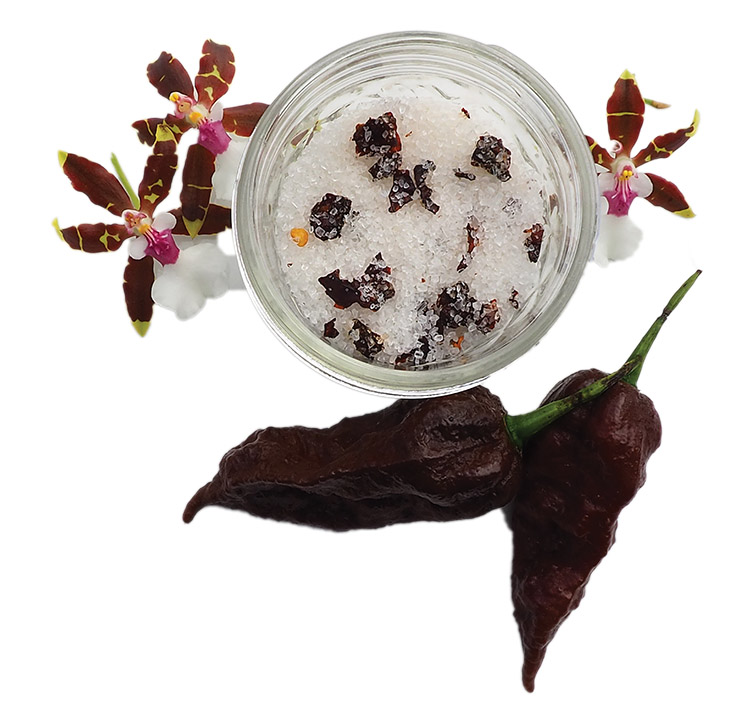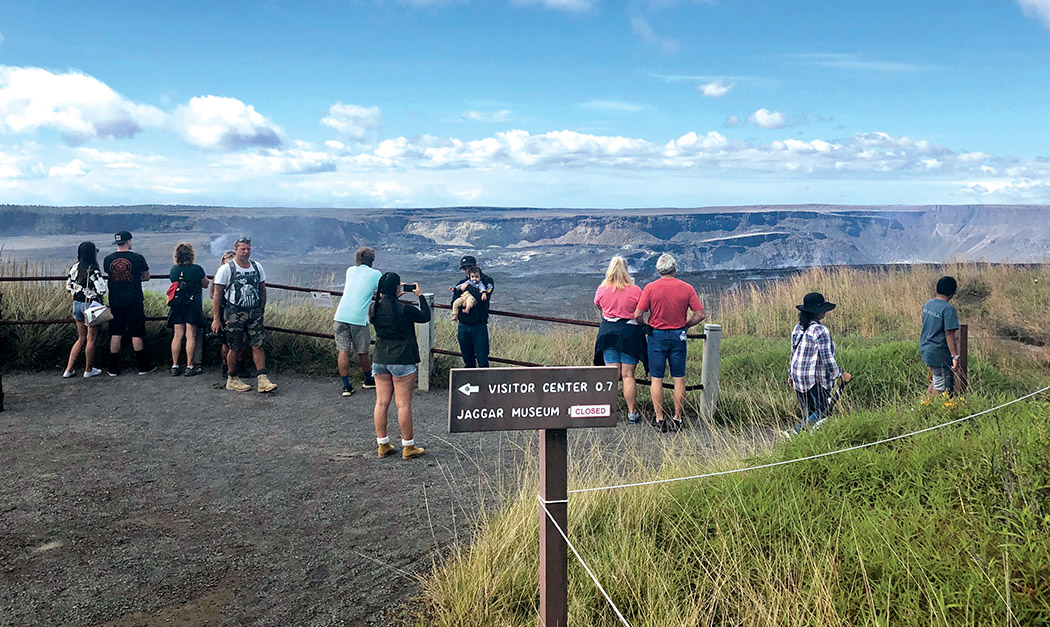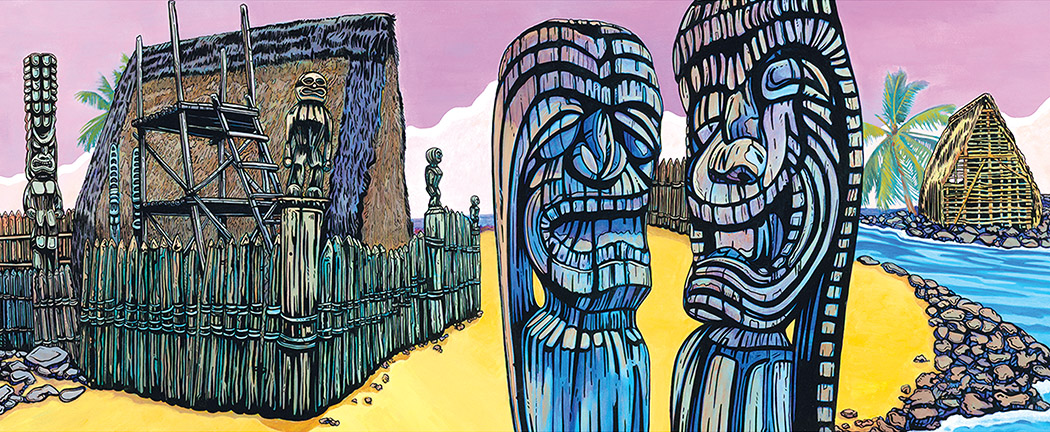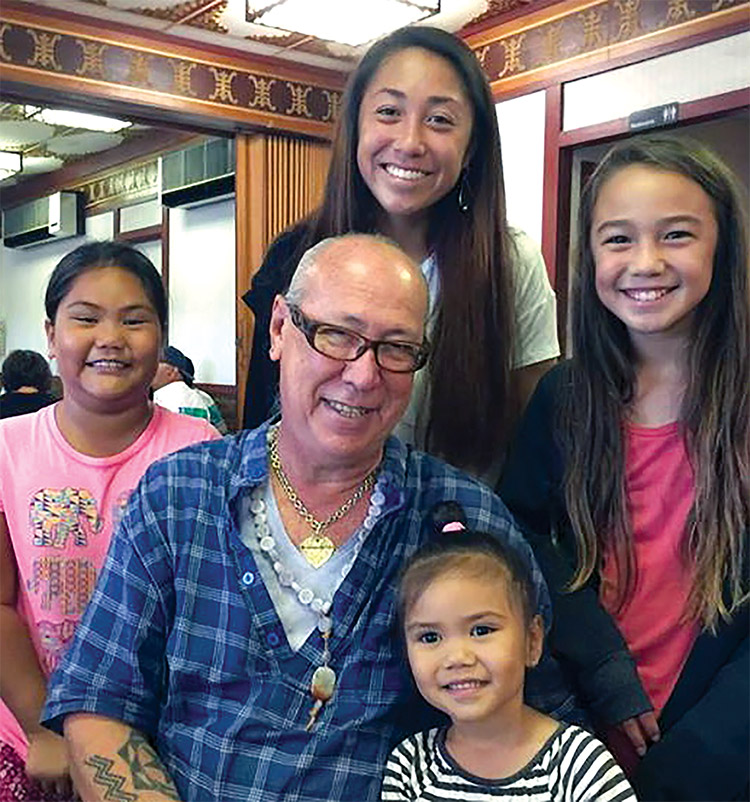
A Journey with Kumu Kawaikapuokalani Frank Hewett
By Karen Valentine
This is a story about one who might be called a Hawaiian renaissance man. This man is multi-facetted and multi-talented, with an insatiable drive to serve his culture through sharing his knowledge. Like a tripod that will fall over without its three legs, Kumu and Kahuna Kawaikapuokalani Frank Loea Lehua Hewett could be called a master of three arts: hula, ho‘opa (healing) and haku mele (song composition). All are woven together, as all are intrinsic to the whole of this man.
Na Kumu (The Teachers)
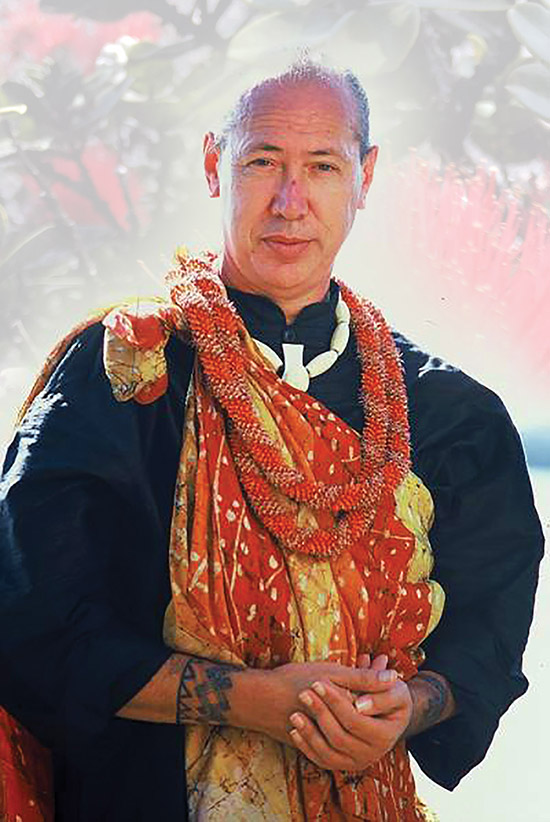
It was said by those who watched the famous hula dancer ‘Iolani Luahine that she seemed to float on air as she moved.
Kahuna (spiritual leader/master) and much-honored Kumu (teacher) Hula Emma DeFries was as much a master healer as a teacher, composer and dancer.
Edith Kanaka‘ole is a legend in hula and Hawaiian cultural teaching, whose name is revered and who founded a family of hula masters.
These beloved teachers of past generations, each of whom passed their ‘ike (knowledge) on to Kawaikapuokalani (Frank) Hewett—also known fondly as Lehua—are recalled by him as he talks story.
Kumu Kawaikapu has himself become a legend in his own lifetime, and embodies many of the qualities of his honored teachers. Following the thread of his comments is like poetry itself, just as watching him dance recalls the grace and etheric nature of Kumu ‘Iolani. He seems to float across the stage in a dreamlike state. Imagine a graceful bird in flight—his long legs, long arms, long fingers trace the story in the air as if he is living it.
History, legend and lineage are woven together in the poetry of song and memory as Kumu Kawaikapu performs, writes songs and tirelessly crosses the globe to teach others. His feet barely touch the soil of his homes in He‘eia, O‘ahu or Ola‘a here on Hawai‘i Island before he is off again, judging a competition or conducting workshops in Japan, Europe or the US mainland. Along the way, stories are woven into songs that will live on long after he is gone.
The young Frank’s kumu and aunty, Emma DeFries, accepted him as a student in 1972 at age 18. He had already been taught hula by his grandmother and possessed musical skills and a compassionate interest in healing. He soon became Kumu Emma’s protégé. Kumu Emma—a direct descendant of Hewahewa, spiritual advisor to Kamehameha the Great—along with his grandmother, gave him the name Kawaikapuokalani (sacred water of the heavens).
“I was born really sickly and throughout my childhood I had been very sick,” Frank says. “As I got older, they wanted to give me something that would give me strength, both spiritual and physical. My grandmother and aunt prayed on it. They received the name Kawaikapuokalani.”
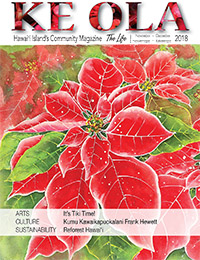
Aunty Emma was a practitioner of the healing traditions of lā‘au kāhea, lā‘au lapa‘au, ho‘oponopono, and lomilomi as well as a musician and kumu hula. As her young student developed into a tall and gangly young man, she encouraged his graceful moves, taping together his ring and middle fingers to help train his hands, he says. Upon his graduation she bestowed upon him additional names.
“When I graduated from Aunty Emma Defries [hālau], she gave me the name Ka Lehua O Ka Hula. Lehua is not only a flower, but also a word for expert. She gave me the lehua as my plant symbol, the color red as my color symbol and also gave me the name of the school, Kuhai Hālau Ō Kawaikapuokalani Pā ‘Ōlapa Kahiko, which I founded in 1978.”
Frank was already a musician, having been taught by his grandmother, a musician and dancer who spoke Hawaiian language at home. Aunty Emma introduced him to Jerry Santos and Robert Beaumont of the famous Hawaiian music group Olomana.
That was the beginning of a relationship that would last 28 years. He performed regularly as principal hula soloist with the group in Waikīkī and also with the famous musician, the late Palani Vaughn. During the late 1970s, he performed with a hula kahiko (ancient style hula) group in Kailua-Kona called E Ho’o Hawai‘i Kakou. During this time he was instructed and mentored by Hula Master ‘Iolani Luahine.
He attended college at University of Hawai‘i at Hilo, during which time he was introduced to Edith Kanaka‘ole. He sat with her and absorbed her stories and shared wisdom.
“My grandmother came to see Aunty Edith Kanaka‘ole. They came from the same place and were somehow related. Aunty Edith became my kumu for ‘ōlelo [language] Hawai‘i and tutored me in poetry. I also learned hula and oli [chanting] from her. I graduated UH Hilo in 1977 with a degree in liberal studies with emphasis on Hawaiian Culture.”
In true Hawaiian tradition, Kumu Kawaikapu honors his kumu and kūpuna. “What they share with you is what you follow. In reflection of that, I wouldn’t be a good example for my students who are trying to follow me. Every moment that I sat with my kumu, every moment they had a free time to talk, they would share with me something. Did the learning ever stop? With my teachers it’s only stopped because they have passed on, but what they shared with me has left such a huge impact that it inspires me to do more and more research.”
In addition to sharing this wisdom within his own hālau and graduating many other kumu, Kumu Kawaikapu has been a perennial judge of the Merrie Monarch Festival and is in much demand to judge other competitions.
Ho‘ola: Healing
“The two words, hula and ho‘ola, are connected. Healing and dance traditions come under the same goddesses: Kapo and Laka, Hi‘iaka and Pele, Hōpoe and Hā‘ena, Keaomelemele and Paliula. These are all hula goddesses but also the goddesses of the preparation of medicine for healing.
“Knowing the prayers taught to me for healing, and learning the same or similar prayers for hula is where everything became connected. From there on the journey became very easy. You dance, you end up with body aches. You stress, you hurt your muscles, then they teach you the lomilomi, the lā‘au lapa‘au [herbs] and the prayers. Same prayers, same goddesses. It’s not like these traditions were so separated far and wide. They were quite closely related and therefore the learning process was not a difficult one.”
Kahuna Emma DeFries also passed along her knowledge of natural medicinal healing, enabling her student to practice native Hawaiian healing modalities such as lā‘au lapa‘au, touch therapy, lomilomi massage, spiritual mediation through chants and prayers, and ho‘oponopono.
Hawai‘i Island Connections
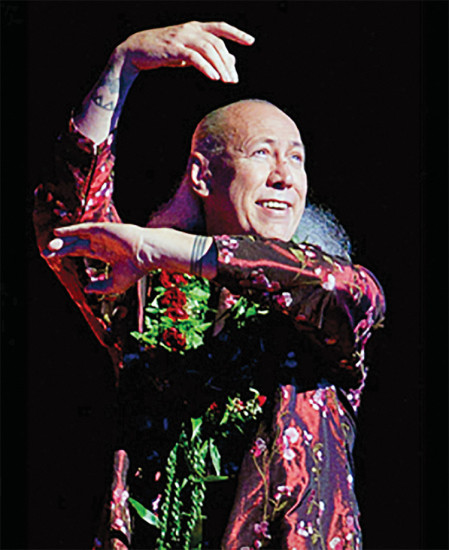
Although Kumu Kawaikapu was raised on O‘ahu and worked there for years, he has a special feeling for Hawai‘i Island, composing many songs based on its goddesses and wahi pana (sacred places). He once had a dream to establish a school here, leading him to search for real estate.
“I had an aunt who was a Kahuna Pule. Her forté was lā‘au kāhea, to heal by prayers. Aunty Momi Ruane served for many years as my mentor and helped me through a lot of things. I had also worked at the Waimanalo Medical Center for 10 years. After graduating from UH Hilo, I always wanted to come back and have a school here—a hula school, a school for healing, for medicines and lomilomi—to fulfill the dream.”
Talking story at his house in Ola‘a, near Volcano, he shares, “And so I called a Realtor and asked them to help me find a place here. When I first walked out on this lānai [porch], I said, ‘Oh my God, ka hale lehua.’ Of course, the home of the lehua blossoms or the expert, the wise person, the skilled person. Also the place where people come to be wise, to be skilled. The owners had some problem with the papers. My aunt prayed with me and asked what I wanted to call it. ‘Ka Hale Lehua,’ I said, also for the hula goddesses. She said the name would make sure everything would work out.”
Goddesses
Through his learning, research and his own genealogy, the famed kumu and musician has written poetry and composed songs that faithfully portray the goddesses of Hawai‘i Island.
“We have a connection to both Pele and Poli‘ahu. When they came to Hawai‘i they were real women who had children. They were elevated to goddesses through the tradition of ancestor or ‘aumakua worship—as actual descendants of people in a community who valued what they did. Pele married Kamapua‘a and they had a son. Pele and Poli‘ahu are sisters. Descendants of each married one another. Queen Ka‘ahumanu made a journey to Maunakea to find the bones of Poli‘ahu. You can read about it. I have a genealogy to Pele, some 24 or more generations back, not that long ago. If you are connected by blood to Pele, then you’re related to Poli‘ahu, to Laka, to all of these people. It’s more than just a story; this is your bones, your flesh, your blood. We talk about it in a different way. We are the living descendants.”
Hōpoe, who is recognized for teaching hula to Pele’s sister Hi‘iaka and to Pele herself in the Puna district of Hawai‘i Island, is the subject of his song “E ‘Ike I Ka Nani A O Hopoe.”
“She was turned to stone, overwhelmed by the fire goddess Pele at Kea‘au. I have gone there, felt the inspiration. I wanted to capture their stories, their life and honor them, not only with the song but also in naming my grandchildren, who all have Lehua as part of their names. It’s to allow them to live again, not only in this world, but with their family, their descendants, their blood relations.”
Haku Mele (Songwriting)
“In haku mele, or poetry, I capture the most important things that I feel at the moment about these fabulous people. Some say my songs are tradition already. They are already recognized as standards in both music and hula. For example, ‘Ka Wai Lehua’ has already been recorded by 65 other recording artists.”
He is known for singing his own songs, and for having his songs recorded by many of the top artists in Hawaiian music. He started recording his own music in the early 1980s and very soon after won his first Nā Hōkū Hanohano Award in 1981: Best Song, Haku Mele for “Ka Wai Lehua A’ala Ka Honua.”
Since then he has written many songs and won many more Nā Hōkū Hanohano awards.
“I started composing music when I was in the 4th grade, under the guidance of my beloved grandmother. She would inspect my use of Hawaiian language to make sure all was done correctly. I loved writing poetry, putting words together. My grandmother’s attention and knowledge were valuable to me when I did my first recordings.”
Kumu Kawaikapu hopes his songs also inform and inspire the issues of today.
“When I wrote ‘Poli‘ahu’ [snow goddess residing at Maunakea] in 1990 or 1992, there was not a protest at Maunakea, but when I wrote about her loneliness in the song, I was thinking, ‘Why weren’t her people there at that time? Were we not ready, not prepared? There are sacred mountains all over this world.’”
“I continue to compose, so this story is far from over.” He is currently working on a song about Lake Waiau.
‘Ohana
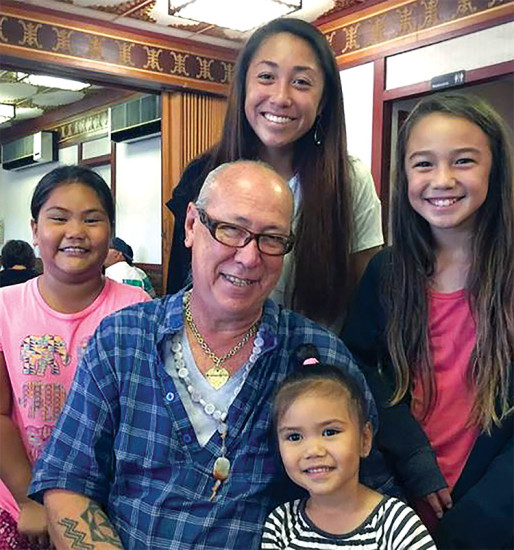
“We are responsible for each generation, parents to children. I have 17 grandchildren all around the world, three great-grandchildren. I like spending time with them, listening to their stories. We get crazy together and I like watching them running around, screaming—it’s joyous. That is what drives me to write poetry, to teach hula: to continue to learn and strive for their betterment. I had to help my mom and my dad to raise my brothers and sisters on a farm, where I worked from sun up to sunset. I sang through everything. I never stopped singing. I made up songs all day long.
“When I was young, preparing for life, my teachers sat me down and told me I would never marry. I did not question. They said to me, ‘You will never have children, yet you will have many, many children.’”
In fact, he had six children, all legally adopted by him. “All carry my last name, Hewett. Some of them were given to me as infants and some older. We found that every single one through DNA is closely related to me. I believe there is a purpose in everything. Once I took them into my home they were in an instant mine, as are their children.”
Kumu Kawaikapu has inherited his drive to help and teach others. “My mom has volunteered for over 50 years in Kāne‘ohe. At 87 now, she is running sports teams. There’s so much more to do. What I do is what the taro farmer or the fisherman would do. You work to take care of your family. My children are my inspiration, the driving force behind me. I’m working to help take care of five generations. I’m going to keep on working as long as I can.”
Teaching
Kumu Kawaikapu conducts training of other kumu hula at his residence here on Hawai‘i Island. He can’t count the numbers he has graduated, but he is clear to teach them in the tradition of his kumu.
“The majority have graduated through the process of Aunty Emma DeFries. What I teach is from that foundation. The most important thing is to have a kahua or foundation that links you to the generation before you to connect with the generations into the future. The relationship between student and teacher is a lifelong relationship that is based on trust, honor, and loyalty—to the school of learning and to the teacher. The teacher also has the responsibility to the student based on the same tradition: respect, honor, and loyalty. I have been teaching now for more than 40 years, and I have students who have been with me for 40 years and still going. I am their parent, teacher, doctor, nurse, advisor, counselor, leader, and everything else. I love and take care of them. When do I plan to stop learning and teaching? When I drop dead. I live for those moments to first research and then share with my students.” ❖
Photos courtesy of Kumu Kawaikapuokalani Hewett
For more information: Kumu Kawaikapuokalani Hewett, kahalelehua@hotmail.com
Mahalo Kings’ Shops – Culture Story Sponsor
